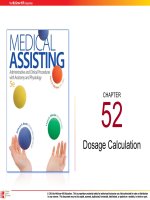Medical assisting Administrative and clinical procedures (5e) Chapter 32 The reproductive system
Bạn đang xem bản rút gọn của tài liệu. Xem và tải ngay bản đầy đủ của tài liệu tại đây (749.92 KB, 61 trang )
CHAPTER
32
The Reproductive
System
32-2
Learning Outcomes (cont.)
32.1
Summarize the organs of the male reproductive
system including the locations, structures, and
functions of each.
32.2 Describe the causes, signs and symptoms, and
treatment of various disorders of the male
reproductive system.
32.3
Summarize the organs of the female reproductive
system including the locations, structures, and
functions of each.
32.4
Describe the causes, signs and symptoms, and
treatment of various disorders of the female
reproductive system.
32-3
Learning Outcomes (cont.)
32.5 Explain the process of pregnancy, including
fertilization, the prenatal period, and fetal circulation.
32.6 Describe the birth process, including the postnatal
period.
32.7 Compare several birth control methods and their
effectiveness.
32.8
Explain the causes of and treatments for infertility.
32.9 Describe the causes, signs and symptoms, and
treatments of the most common sexually transmitted
infections.
32-4
Introduction
• Male and female reproductive systems
– Function together to produce offspring
– Produce important hormones
32-5
The Male Reproductive System
• Testes
– Produce sperm and
testosterone
– Divided into lobules
– Held in the scrotum
• Seminiferous
tubules
– In the lobules of the
testes
– Contain
spermatogenic cells
• Interstitial cells
produce testosterone
Male
System
32-7
Sperm Cell Formation
Spermatogenesis
Spermatogonium (46 chromosomes)
Mitosis
Primary spermatocytes
(46 chromosomes)
Meiosis at puberty
Secondary
spermatocyte
Spermatid
Spermatid
Secondary
spermatocyte
2nd meiotic
division
Spermatid
Spermatid
32-8
Sperm Cell Formation (cont.)
• Head
– Nucleus with 23
chromosomes
– Covered by an
acrosome
• Tail
– Flagellum
– Propels
the sperm
• Midpiece - mitochondria
32-9
Internal Accessory Organs – Male
• Epididymis –
where spermatids
mature into sperm
• Vas deferens –
carries sperm cells
to urethra
• Seminal vesicles –
secrete seminal
fluid
– Sugar
– Prostaglandins
Male
System
32-10
Internal Accessory Organs – Male
• Prostate gland
– Alkaline fluid that
protects sperm
– Contractions assist
with expulsion of
semen
(cont.)
• Cowper’s glands
– fluid to lubricate
end of penis
• Semen
– Sperm cells
– Fluids
Male
System
32-11
External Organs – Male
• Scrotum
– Pouch that holds
the testes away
from the body
– Lined with serous
membrane that
secrets fluid
• Penis
– Shaft
– Glans penis
– Prepuce
– Functions
• Deliver sperm
• Urination
Male
System
32-12
Erection, Orgasm, and Ejaculation
• Erection – erectile tissue becomes
engorged with blood
• Orgasm - emission occurs
• Ejaculation – semen is forced out of the
urethra
32-13
Male Reproductive Hormones
• Gonadotropin-releasing hormone (GnRH)
• Follicle-stimulating hormone (FSH)
• Luteinizing hormone (LH)
• Testosterone
– Secondary sex characteristics
– Maturation of male reproductive organs
– Regulated by negative feedback
32-14
Apply Your Knowledge
Matching: ANSWER:
D Vasectomy
___
A. Spermatogenesis
B. Testes
F Mixture of sperm and fluids
___
C. Penis
A Sperm cell formation
___
D. Vas deferens
G Secrete alkaline fluid/
___
prostaglandins
E. Hypothalamus
B Produce testosterone
___
G.Seminal vesicle
E GnRH
___
C Erectile tissue
___
F. Semen
Common Diseases and Disorders of the Male
Reproductive System
Disease/Disorder Description
Benign prostatic
Nonmalignant enlargement of
hypertrophy (BPH) the prostate gland
Epididymitis
Inflammation of an epididymis;
usually starts as an urinary
tract infection
Impotence or
Disorder in which erection
erectile dysfunction cannot be achieved or
(ED)
maintained; about 50% of
males between 40 and 70
have some degree of ED
32-15
Common Diseases and Disorders of the Male
Reproductive System (cont.)
Disease/Disorder Description
Prostate cancer
Most common form of cancer in
men over 40; risk increases
with age
Prostatitis
Inflammation of the prostate
gland; may be acute or chronic
Testicular cancer
Malignant growth in one or both
testicles; more common in
males 15–30 years; aggressive
malignancy
32-16
32-17
Apply Your Knowledge
ANSWER:
Match:
C More common in men over 40 years
old.
A Common in older men; symptoms
include difficulties with urination.
D More common in males 15-30 years
old; aggressive.
B Often starts as urinary tract infection;
symptoms include swelling of the
scrotum and painful ejaculation.
A. BPH
B. Epididymitis
C. Prostrate
cancer
D. Testicular
cancer
32-18
The Female Reproductive System
• Ovaries
– Produce ova, estrogen, and progesterone
– Medulla ~ nerves and lymphatic and blood
vessels
– Cortex ~ ovarian follicles
Female
System
32-20
Ovaries and Ovum Formation
Primordial follicles
•Primary oocyte
•Follicular cells
Polar
body
Secondar
y oocyte
Oogenesis
At puberty
Primary oocyte
stimulated to
continue meiosis
Released during ovulation
Ovum, if fertilized
32-21
Internal Accessory Organs – Female
• Fallopian tube – oviduct
– Infundibulum and fimbriae
• Fringed, expanded end of fallopian tube near ovary
• Function to “catch” an ovum
– Muscular tube
• Lined with mucous membrane and cilia
• Propels ovum toward uterus
Internal Accessory
Organs
32-22
Internal Accessory Organs – Female (cont.)
• Uterus
• Vagina
– Receives embryo
and sustains its
development
– Extends from
uterus to outside
body
– Divisions
– Rugae
– Wall ~ three layers
– Wall ~ three layers
Internal Accessory
Organs
32-24
External Accessory Organs - Female
• Mammary glands
– Secretion of milk
– Structures
• Nipple
• Areola
• Alveolar glands
32-25
External Genitalia – Female
• Vulva
– Labia majora
• Adipose tissue and skin
• Form the mons pubis
– Labia minora
•
•
•
•
Vascular folds of skin
Form hood over clitoris
Vestibule
Bartholin’s glands
• Clitoris
– Contains female
erectile tissue
– Rich in sensory nerves
• Perineum – between
vagina and anus
Female
System
32-26
Erection, Lubrication, and Orgasm
• Nervous stimulation
– Clitoris becomes erect
– Bartholin’s glands activate
– Vagina elongates
• Orgasm
– Sufficient stimulation of clitoris
– Walls of uterus and fallopian tubes contract to
propel sperm
32-27
Female Reproductive Hormones
Hypothalamus
secretes GnRH
GnRH
m
Sti
Ovaries to
produce
estrogen and
progesterone
Anterior pituitary
releases FSH & LH
tes
a
l
u
Estrogen and progesterone are
responsible for development of
secondary sex characteristics
32-28
Reproductive Cycle
• Menstrual cycle
– Regular changes in uterine lining
– Shedding of lining and bleeding
• Menarche – first menstrual period
• Menopause – termination of cycle due to normal
aging of ovaries









